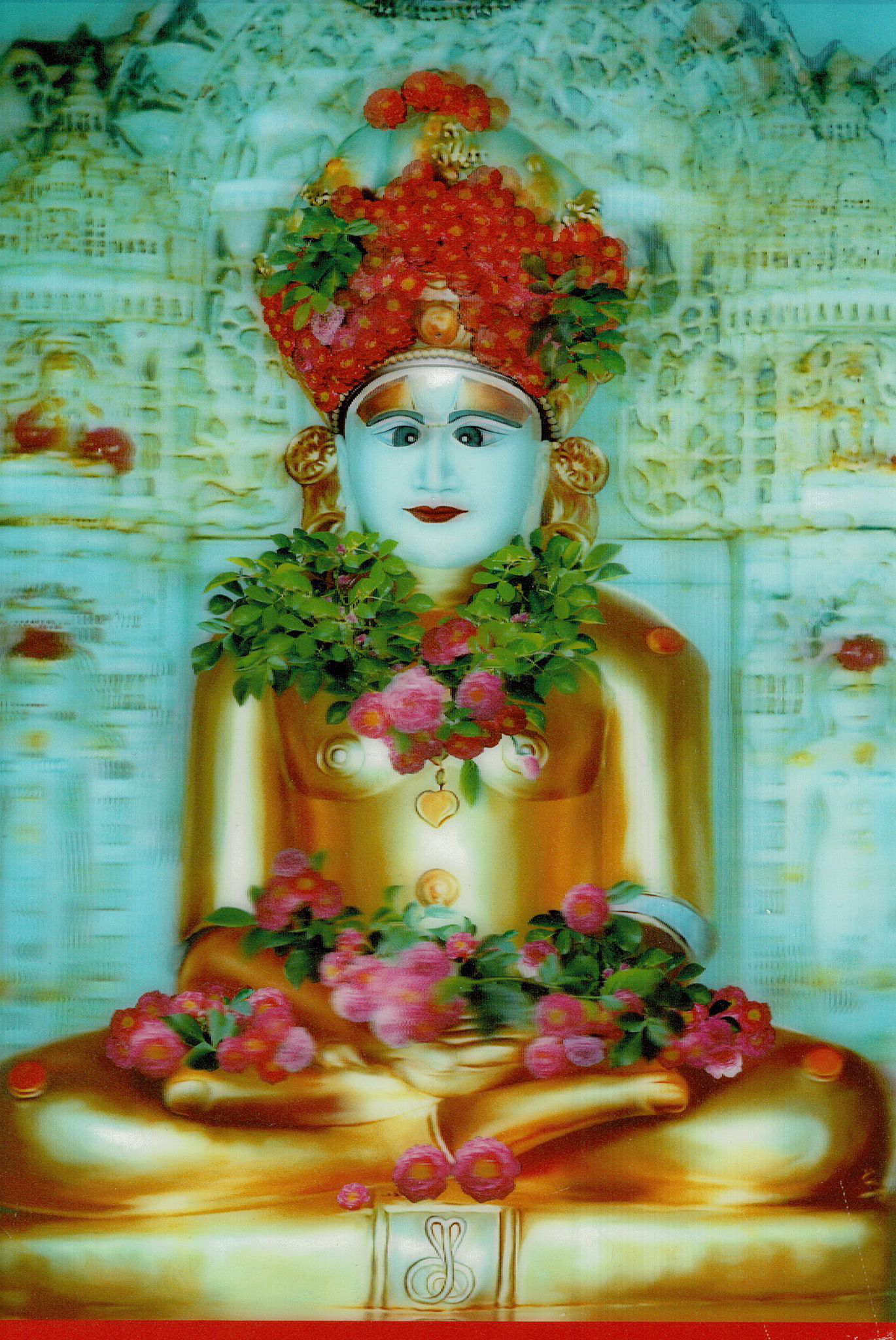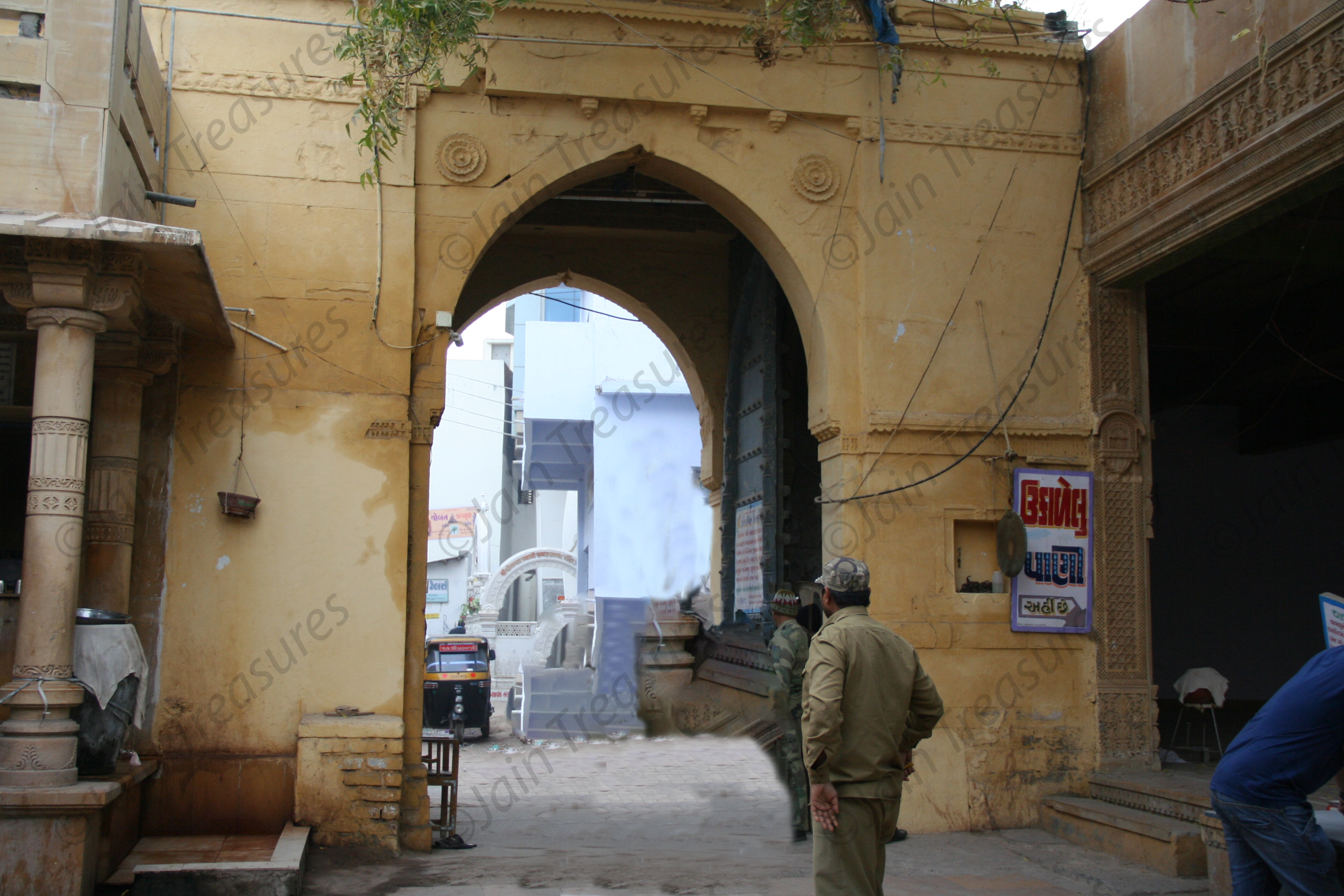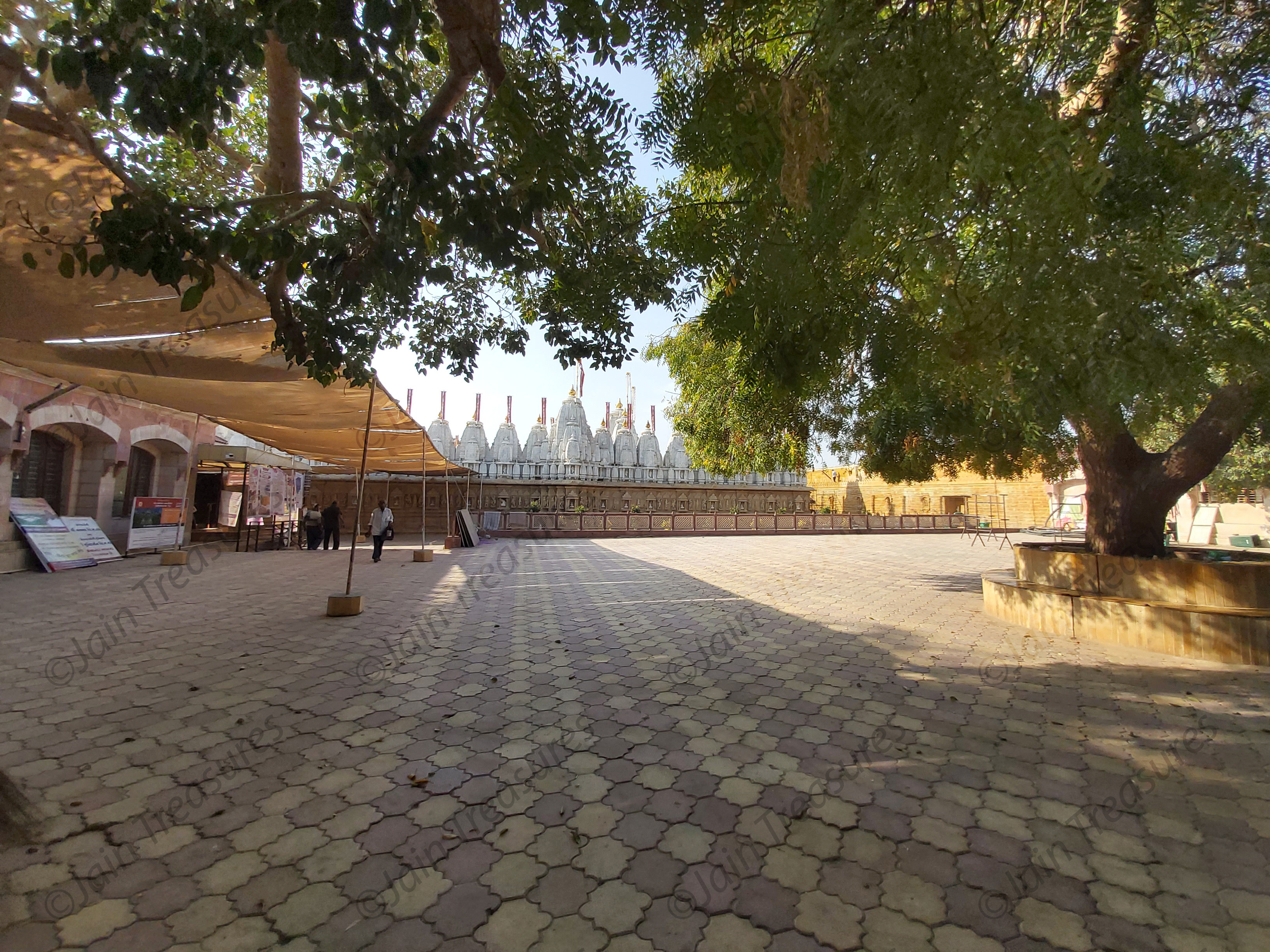Shankeshwar is one of the most important tirths for the Jains. Have you ever wondered who built the temple and how old is the murti?
The history of Shankeshwar Parsvanāth’s exquisite murti (idol) goes back a very long time back in the past.

In fact, so long that according to the Jain time cycle, it goes back to the previous Utsarpini kaal. During this time cycle, when the 9th tirthankar Damodar swami was on earth, there was a devotee by the name of Ashadi Shrāvak. When he went to the Lord’s assembly, he asked the Lord as to when will he get moksha (liberation)? The Lord replied, that during the next time cycle, when Lord Parsvanāth will be on earth you will become his ganadhara (chief disciple) and at the end of that lifetime you will attain liberation. He was ecstatic to hear this and asked Damodar swami to describe the appearance of Bhagwān Parsvanāth. He got skilled cratfsmen to create a murti and revered it daily. At the end of his lifespan he got reincarnated in the Saudharma heaven. All heavenly celestial beings have innate avadhi gyana (clairvoyance). Utilising this knowledge he realised that he attained the heavens due to his devotion to Bhagwān Parsvanāth’s murti and decided to bring it to the heavens. Celestial beings have long lifespans and therefore this murti has been revered by countless of heavenly divine beings across different regions within the Universe (e.g. 1st heaven, 2nd heaven, 10th heaven, 12th heaven, Bhavnapati, Vyantara nagar). It is also believed to have been consecrated at Mount Girnar.
Lord Adeshwar’s grandsons, Nami and Vinami, prayed to Shankeshwar Parsvanāth’s murti for eons. It is believed that even Rām & Sitā prayed to this murti.
During the time of Tirthankar Nemināth Bhagwān, Krishnā Māhārāj was his cousin. Jarāsandh (Prativasudeva) who was a powerful evil ruler waged war on Krishnā Māhārāj who was a Vasudeva. Jarāsandh had special powers whereby he immobilised Krishnā’s army and they all became unconscious. Krishnā Māhārāj was bewildered what to do and turned to his cousin Nemināth Bhagwān for advise. Lord Nemināth told him to do atham tapa (fasting for 3 days) and then when the divine Padmāvati Goddess appears ask her to get Shankeshwar Parsvanāth’s murti from Pātala Loka. The Goddess obliged and got the murti.

Jarāsandh released a cakra (powerful disc) on Krishnā Māhārāj. However, as Krishnā was a Vasudeva it circled him thrice without harming him whatsoever, and instead returned to Jarāsandh and killed him.
Krishnā Māhārāj did abhishek (ablution) to the murti and sprinkled the water over his army who immediately got up. He was overjoyed and blew the conch (Śaṅkha शङ्ख) shell in euphoria.
The town became known as Shankhpura (pura (पुर) means town or city). He then thought who should be crowned king of this town, and decided it cannot be anyone else besides this majestic murti (idol). Īśvara (ईश्वर) means Lord or Master, therefore this murti was named as Shankeshwar Parsvanāth and consecrated in a temple at this town.
With the passage of time, there would have been numerous natural (earthquakes, floods) and human calamities (attacks by infidels) resulting in moving and protecting the murti either by humans or celestial heavenly beings.
Although the history of this murti is billions of years old, current records date around the 11th / 12th century AD. Sajjan Mantri was a minister during the reign of Jayasimha Siddharaja. Whilst he was on his way to Girnar he came to Shankeshwar and did the first recorded renovations to the temple.
As time moved on, around 1250AD, Vastupāl & Tejpāl brothers were ministers in the court of King Dhaval who had made unparalleled contribution to the construction of many Jain temples. They carried out the second renovation and decided to build 52 smaller shrines around the main temple of Shankeshwar Parsvanāth. Their spiritual guru was Acharya Vardhamān Suri. One day Āchārya heard that Vastupāl had passed away and was in tears as the Jain Sangh had lost such a great benefactor. Can you imagine Vastupāl’s reputation and personality that an eminent Āchārya shed tears in his memory. To overcome his grief, he decided to start a penance which is even today called Vardhamān Tapa. It consists of doing 1 Ayembel followed by 1 Upwas, 2 Ayembel followed by 1 Upwas and so on until you get to 100 Ayembel. This takes over 14 years to complete with no breaks in between. After completing this mammoth fast, he decided to do his pārnu (break his long fast of more than 14 years) at Shankeshwar. The Jain community joined him to proceed to Shankeshwar. Being weak after such a strenuous fast and due to intense heat, the Achārya passed away before reaching Shankeshwar. He reincarnated as a celestial divine God and is the Adhistayaka Deva (guardian deity) of Shankeshwar Tirth who helps all genuine devotees who revere the Lord that is so dear to him.
In the 14th century, the Moslem rulers were destroying Hindu and Jain temples. They had just desecrated the temples at Somnath and were approaching Shankeshwar. The Jain sangh (community) decided to bury the ancient idol, as if the temple is destroyed it can be built again, but how can you recreate such a divine murti such as this again?
Near to Shankeshwar, is a town called Zinzuwada and the local king was Raja Durjan Sal. He had leprosy and was in acute pain. None of the vaids (Vaidya (वैद्य) refers to a “medical practitioner”) could alleviate his pain. Being a devout Hindu, he prayed to the Sun God. In his dream, he received a premonition to go to Shankhpura and at a particular location he would find the murti of Shankeshwar Parsvanāth buried underground. He unearthed the murti at the exact location he dreamt of and the mere touch of the murti cured his illness. He built a new temple and installed the murti.
Jain templess were desecrated during the reign of Aurangzeb and other Moslem rules. Once again, the Jain community decided to bury the idol underground.
In the 17th century, there was a herdsman who noticed that one cow in partciular was not producing any milk. He decided to observe her and noticed that whilst he took it to the fields at a particular spot, all her milk oozed out. The locals advised him that there must be something unique about that spot. When they dug, they found the idol of Shankeshwar Parsvanāth. Not knowing the importance of this murti, Āchārya Hirvijaysuri’s disciple Pujya Sensuri Māhārāj explained the significance of this murti to the community who decided to build a grand temple with 52 shrines around the temple complex.
Once Upādhyāya Udayratan Māhārāj was based in Kheda and after the chaturmās (rainy sojourn) decided to go with the sangh to Shankeshwar. There was immense excitement and fervour on doing darshan of Shankeshwar Parsvanāth. At that time, town was under the control of the Thākurs who had decreed that each and every pilgrim had to pay a tax of 1 golden guinea to do darshan of Shankeshwar Parsvanāth. When the entire sangh reached Shankeshwar, the doors were closed by the guards who demanded 1 golden guinea from each and every person if they wanted to enter the temple. Many within the group had fasted and resolved that they will only break the fast after doing darshan of their Lord Shankeshwar Parsvanāth. Upādhyāya Udayratan Māhārāj found this to be gross injustice. With utmost devotion he started to plea to Shankeshwar Parsvanāth behind the closed doors.
“Oh God, why are you keeping a curtain between us?
The Thakur’s Chakur’s (employees) are demanding payment from the sangh! Reveal to us, Oh Lord! Don’t hide inside…if you want to hide, then please hide inside our hearts!”.
As he sang such a heartfelt plea to the Lord, the doors flung open and the entire sangh rejoiced at being able to do darshan of Shankeshwar Parsvanāth.
There are many miracles associated with devotion to Shankeshwar Parsvanāth. One such recent example is that of a lady who lost her husband soon after her child was born. She was in distress as to how she will make her ends meet. She prayed to Shankeshwar Parsvanāth that once she makes enough money she will make a pilgrimage to Shakeshwar and offer money / ornaments equal to her son’s weight. After some time, she embarked on her pilgrimage and along the way, dacoits stopped her to steal her possessions. She was terrified, closed her eyes and wondered what will she offer when she reaches Shankeshwar Parsvanāth. Suddenly, a figure on a black horse appeared and the looters ran away. The figure told the lady not to worry about her journey and that he will accompany her all the way to Shakeshwar. As soon as she reached the gates of Shankeshwar, she looked back to thank the person and saw that both the horse and the figure had disappeared. What a miracle!

Devotees (both householders and ascetics) pray to Shankeshwar Parsvanāth to alleviate any of their mental, physical or emotional ailments. In the 17th century, Acharya Yashovijayji was an erudite scholar and outstanding logician who often argued against conventional norms and rituals which he felt were against the true essence of the Jain philosophy. As a result many communities and sects excommunicated him. Many started spreading rumours against him, rebuking him for his outspoken comments and trying to taint his character with false allegations. Once, during his vihāra (विहार wandering of Jain ascetics by foot), he reached an upāśraya (उपाश्रय, shelter of Jain ascetics), but the Trustees did not open the door for him. Without food or water he carried on to the next few towns but none of the Jain community entertained him. Ascetics hold utmost equanimity, but after all they are humans. After a few days with no shelter, food or water he started to become helpless and was getting difficult to maintain his calm and poise. He decided that his only refuge is that of Shankeshwar Parsvanāth. As soon as he reached there, he went inside the temple and poured his heart out in front of Shankeshwar Parsvanāth’s murti. He cried to the Lord as to what has he done that the entire community is against him. In this agony he composed a Stuti (in the form of a complaint) to the Lord…Who do I go to? What have I done? Where are you? I am speaking the Truth and no one is willing to listen. You are my dhanī (धनी, master), I am helpless. Oh Lord, why is there mithyātva (मिथ्यात्व, wrong faith). He decided to do atham tapa (fast for three days) after actually having starved for days and became engrossed in chanting the name of the Lord (Shankeshwar Parsvanāthay Namah). Thereafter he gained strength to face the community with renewed vigour and enthusiasm.



Source:
1. Translated into English from Pujya Shree Muni Jinchandraji Maharaj’s Discourse on Shankeshwar Parsvanath
2. Internet
Please pardon and forgive if there are any inadvertent errors or mistakes in the information provided









